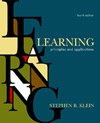- Who is Martin E. P. Seligman, and what might have led him to develop the theory of learned helplessness?
LEARN TO BE HELPLESS
http://www.noogenesis.com/malama/discouragement/helplessness.html
This site gives a historical look at Martin E. P. Seligman and the development of learned helplessness theory.
- Since its inception, learned helplessness has been applied to many different situations. Some examples are listed here. Read the examples and determine for yourself if learned helplessness really applies.
ANOTHER CONSEQUENCE OF AIDS
http://www.shearonforschools.com/learned_optimism.htm
This is a brief poster giving some research on learned-helplessness and HIV.
BREAKING THE CYCLE
http://survivorsofdv.website-works.com/paper.html
This link is to a paper in which the author outlines how battered women may get out of the battering situation. Learned helplessness is utilized in the analysis.
QUIET, PLEASE.
http://www.fican.org/download/Effects_aircraft.pdf
This link is a government report in which the effects of aircraft noise on learning are discussed. How could some of these effects be due to learned helplessness?
- What is "cognitive behaviorism" according to Tolman? How did it change from its original conception?
PURPOSEFUL ACTIONS
http://psychclassics.yorku.ca/Tolman/formula.htm
A COGNITIVE MAP
http://psychclassics.yorku.ca/Tolman/Maps/maps.htm
These are links to two of Tolman's classic papers in pdf format. Read them to discover what Tolman meant, and how he modified the theory.
- What are modern applications of purposive behaviorism?
NOT A ROBOT, A BUGBOT
http://www.cc.gatech.edu/aimosaic/robot-lab/research/eBug/
This link provides a description of a modern idea (a robot) based on Tolman's concept of the schematic sowbug in his paper "Prediction of Vicarious Trial and Error by Means of the Schematic Sowbug" (Psychological Review).



 2002 McGraw-Hill Higher Education
2002 McGraw-Hill Higher Education